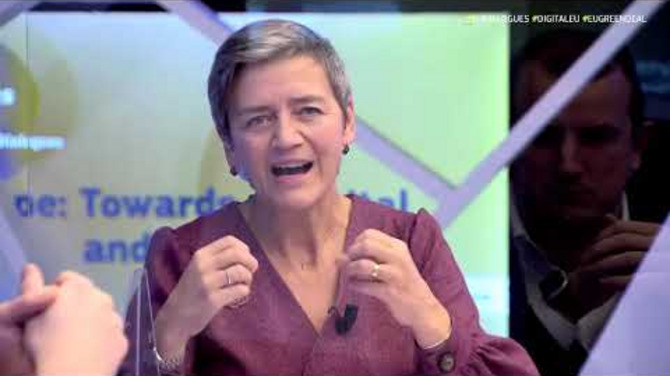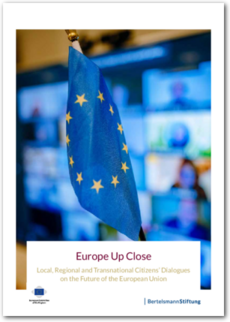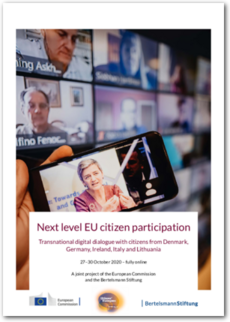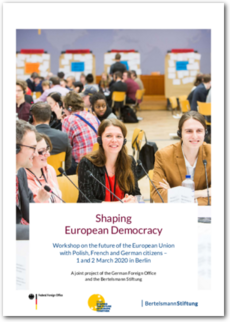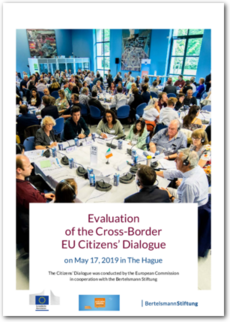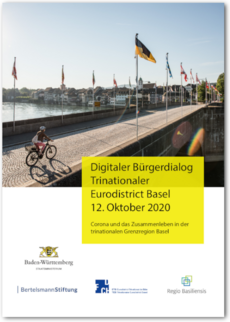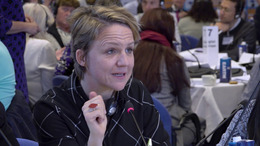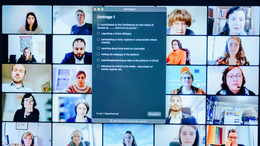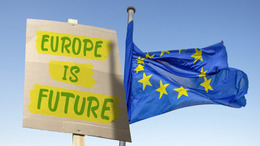This page contains everything you will need—from templates for random selection of participants or blank moderation templates, draft invitation letters, suggestions for project reports or evaluation questionnaires for Citizens’ Dialogues participants to concrete examples of ice-breaker or welcome procedures and methods—as downloads in English.
![[Translate to English:] Menschen diskutieren beim Bürgerdialog](/fileadmin/files/_processed_/b/e/csm_1045556754Europawerkstatt-9302_ed0c73a8d0.jpg)
© Sebastian Pfütze
Practical hints for inclusive, deliberative and effective citizen participation
You can find more than 30 items of practical material—such as guidelines, templates and examples—for good citizen participation here. This material was used in the project “From local to European”, which is run jointly by the European Committee of the Regions and Bertelsmann Stiftung. The material ensured that quality principles were upheld in 38 Citizens’ Dialogues with around 2,000 citizens from 67 European cities and regions.
Content
Qualitiy principles for good citizen participation
Many years of experience show that the quality, results and effects of Citizens’ Dialogues are greatly improved if they are well structured and organised according to the quality principles for good citizen participation.
- Inclusion: Ordinary citizens take part—not just the usual suspects.
- Deliberation: All citizens have their say in large and small discussion rounds.
- Effectiveness: Administrators and policymakers are involved right from the start, so they can ensure that the results of the citizens’ deliberations are followed up and, at least partly, implemented.
One consequence of using these methods and quality principles is that citizens put forward high-quality proposals and policymakers listen to them. In the consensus-oriented discussions, the diversity of perspectives, factual information and arguments is key. Politicians find out what is important to the general public from citizens who represent the diversity of society. The new insights they gain mean they are better equipped to make political decisions which are highly acceptable to citizens because they reflect grassroots needs and wishes. Citizens contribute directly to political processes with their interests and ideas, thereby playing an active role in shaping policy. This, in turn, raises confidence in the political system and increases satisfaction with democracy.
Material and handouts for inclusive, deliberative and effective citizen participation
This introduction contains information about presentations which outline the methods used for inclusive, deliberative and effective citizen participation.
Introduction – Quality criteria
This presentation is an introduction to the method of inclusive, deliberative and effective citizen participation. It provides basic knowledge about the quality charactreristics and their role in assuring successful citizen participation.
Introduction—Practical planning and design of Citizens’ Dialogues
This presentation deals with the cornerstones for planning and designing good Citizens’ Dialogues. It focuses on practical planning aspects and the possible design of citizen participation projects.
Introduction—Implementation of Citizens’ Dialogues
This presentation deals with the concrete implementation of inclusive, deliberative and effective Citizens’ Dialogues: Implementing, evaluating and documenting Citizens’ Dialogues successfully and with good results.
Inclusion
Inclusion and diversity are the first key elements of high-quality citizen participation. Inclusivity is mainly achieved by the random selection method. Citizens’ Dialogues are aimed at “normal citizens” from all levels of society i.e., not just ‘organised’ citizens or representatives of civil society organisations. The citizens are chosen at random, thus guaranteeing a wide range of different opinions and viewpoints. The results of the discussions represent the diversity of society as a whole, therefore creating innovative ideas and balanced proposals.
This section includes handouts, practical solutions and concrete templates for the practical use of random selection in citizen participation processes.
General overview of recruitment processes
Whether citizens are selected at random or addressed directly, you will find a concise summary of the individual steps for recruiting participants here.
Recruitment process example
A practice-oriented illustration of a concrete participant recruitment process with random selection, showing the relevant milestones on the route to a successful dialogue, the key practical questions and the time resources required.
Template for a request for data from the population register
Data from the population register or another similar, publicly accessible database is often the easiest way to address a random selection of citizens. Our template for a request to extract data from one of these registers will be helpful when you contact the responsible authorities.
Template for a citizen’s invitation
Since the random selection of citizens for participation processes is a tried and tested way of creating real diversity of opinion in Dialogue events, this procedure is used more and frequently—typically by taking random samples from the population register. This sample letter will help you when you first approach the participants who were randomly selected in this way.
Sample registration form
Our sample registration form for interested citizens will help you to support the participants and collect the relevant information.
Overview chart—State of recruitment
Recruiting participants is a constantly changing process. A tabular overview of all participants will help to give you an at-a-glance picture of the state of recruitment at any given time.
Example of event information for citizens
An overview of the subject and location of the event, the time schedule and other important information will give citizens orientation and a sense of security. Our template has already proved its worth in numerous citizen participation projects.
Example of event information for citizens (digital)
Log-in data for the event, subject and time schedule—our tried and tested template includes everything citizens will need for orientation and a sense of security when taking part in your concrete citizen participation project in a digital space.
Key points for formulating a service provider contract
An overview of necessary tasks, the timeframe and the division of labour for the performance of the random selection process provides you with guidance on the necessary key points for the formulation of a contract with a potential service provider.
Deliberation
The second key element of quality citizen participation is deliberation. Citizens follow participative methods to exchange different experiences and viewpoints and develop joint ideas and proposals. Deliberation mostly takes places in mixed small groups with the support of moderators, who ensure that all participants get a chance to have their say. Factual information and visiting experts help to provide fair and balanced arguments.
The following section contains documents ranging from templates for detailed time schedules to pre-formulated moderator contributions and warm-up exercises. In short: practical support for the successful staging of your Citizens’ Dialogue.
5 steps for the development of citizens’ proposals
This is an example to show the five steps for the development of citizens’ proposals. Key questions help to structure the moderator’s work.
Factors for high-quality processes and results
There are six fundamental factors which should be considered when planning (transnational) Citizens’ Dialogues.
Example: Time schedule for offline events
Arrival times, technical check, group sizes, table & seating arrangements and suggested wording for moderators: this standardised time schedule provides the basic framework for planning and staging an individualised Citizens’ Dialogue.
Example: Time schedule for online event
This standardised time schedule, which includes a list of technical and conceptual requirements, provides the basic framework for planning and staging an individualised Citizens’ Dialogue. It covers everything from the technical requirements to exact role allocation or suggested wording for moderators.
Icebreaker question examples
Find examples of warm-up questions to break the ice, get to know each other, or introduce the topic–for a Citizens’ Dialogue here.
Example of a multilingual face-to-face dialogue—getting to know each other without a translator
It is especially important that citizens get to know each other and get a feel for the atmosphere of the room in the context of multilingual Citizens’ Dialogues. Our warm-up questions will help to break the ice.
Example for a multilingual dialogue onsite - Getting to know each other without translation
Examples of warm-up questions for online dialogues
Even in digital spaces, warm-up questions help participants to get to know each other and create a relaxed atmosphere of mutual trust. You can find concrete examples here.
Effectiveness and Evaluation
The third key element is effectiveness. The Citizens’ Dialogue is embedded in a political process of opinion-forming and decision-making. Political decision-makers are involved from the very beginning and join the discussions about the ideas and proposals put forward by the citizens. They give feedback, explain how they would like to act upon the results, and ultimately decide on how the citizens’ proposals should be implemented.
This section contains information about the effectiveness of Citizens’ Dialogues as well as evaluation examples and suggestions.
Effectiveness of Citizens’ Dialogues: 3 criteria for selecting the appropriate topic
The topic of a Citizens’ Dialogue should be relevant and within the sphere of influence of the politicians involved, so that the results of the Citizens’ Dialogue can be put into practice. There are three criteria which will help you to find the right topic for a Citizens’ Dialogue.
Effectiveness of Citizens’ Dialogues: 3 criteria for selecting the appropriate topic
Examples of advance evaluation questions
When participants answer questions in the run-up to the event or project, it is possible to draw conclusions about changes to attitudes or viewpoints. You can find a selection of questions that could be asked before an event here.
Sample evaluation sheet for offline events
A sample evaluation sheet for a face-to-face Citizens’ Dialogue can be found here.
Sample evaluation sheet for online events
A sample evaluation sheet for a digital Citizens’ Dialogue can be found here.
Sample feedback sheet for moderators
You can find examples of questions that the moderators involved could answer to follow up/review your event here.
Sample feedback sheet for translators
You can find examples of questions that the translators involved could answer to follow up/review your event here.
Example: Multilingual digital Dialogue—Evaluation in five languages
Contains slides with sample evaluation questions in five languages: DE, DK, EN, IT, LT
Example multilingual digital dialogue - Citizens evaluation in five languages
Templates and examples for programme implementation
This section contains presentations and citizen’s guidelines for online and offline events, technical tips and instructions for citizens on how to use online tools, and other information about organisational matters and the implementation of the programme.
Example: Stage directions for multilingual digital Citizens’ Dialogues
Includes a collection of slides with stage directions to guide citizens through a multilingual digital Citizens’ Dialogue.
Example: Stage directions for multilingual face-to-face Citizens’ Dialogues
Includes a collection of slides with stage directions to guide citizens through a multilingual face-to-face Citizens’ Dialogue.
Example of discussion rules in small groups
You can find four simple rules as basic principles and a code of conduct for discussions in small groups here.
Sample worksheet for work in small groups
Includes a sample worksheet for work on the topics Digital, Social and Global Europe in small groups.
Example: IT instructions for a transnational digital Citizens’ Dialogue
From a citizen’s point of view, the biggest hurdle for participation in a digital Citizens’ Dialogue is joining a concrete meeting. These step-by-step instructions guide citizens through the points they need to know about to take part.
Example: IT instructions for Transnational Digital Citizens' Dialogue
Sample e-mail with Zoom links for citizens
Clear communication of the various links for taking part is vital to ensure the easiest possible access to the Dialogue. The sample e-mail for communication of various Zoom links is a concrete example of how to do this.
Travel expenses form
Participation in face-to-face Dialogues often entails travel expenses. This simple claim form ensures the smooth, error-free reimbursement of citizens’ travel expenses.

![[Translate to English:] Fahnen Hierlemann](/fileadmin/files/_processed_/c/e/csm_1035672943201027_besimmazhiqi-2_c66bb191b7.jpg)
